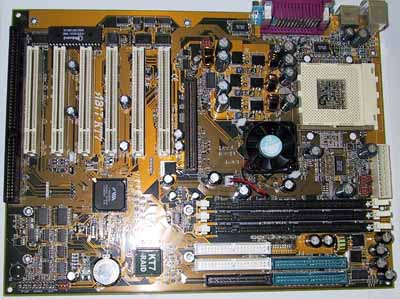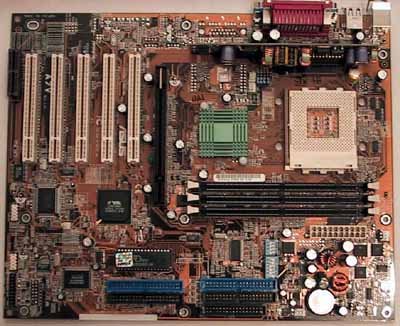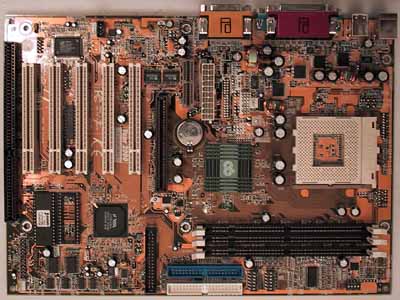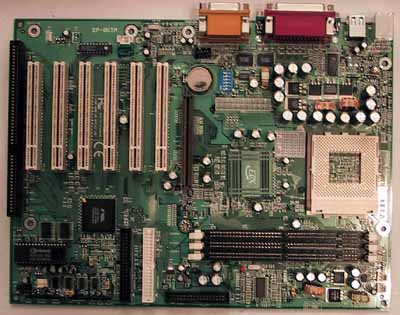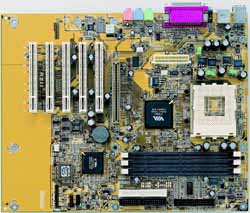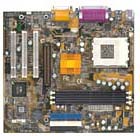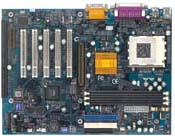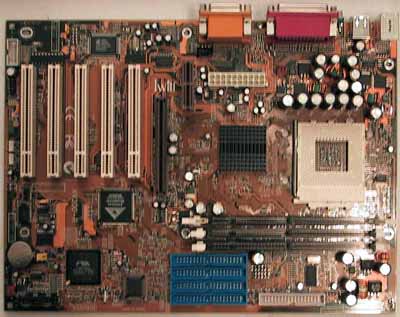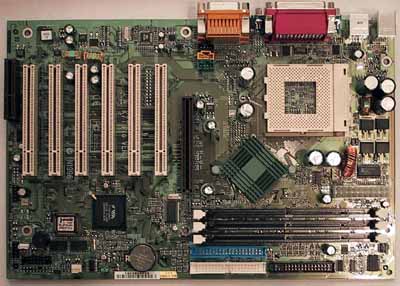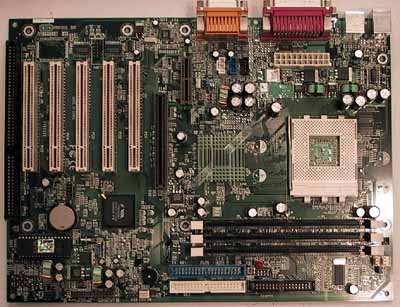
Original Link: https://www.anandtech.com/show/597
Socket-A VIA KT133 Motherboard Roundup - August 2000
by Anand Lal Shimpi on August 9, 2000 12:08 PM EST- Posted in
- Motherboards
When AMD first released the Athlon, the CPU garnered enough attention so that the company could start to be taken seriously as a fierce competitor to the previously dominant Intel. But if you look at it, there is a lot that has happened which has helped to ensure that the Athlon was much more than just a one hit wonder from AMD.
Among the most important players in this ballgame were, of course, the motherboard manufacturers. Without their continued support, albeit a tad slow at the start (we all remember the trouble we had getting motherboard manufacturers to support the Athlon at the beginning right?), the Athlon would have never had the opportunity to be put up against Intel's Pentium III. As great of a CPU as it is, the Athlon would have never been able to survive had it not been for the support of the handful of motherboard manufacturers that helped to carry the Slot-A CPU out of its infancy.
Luckily, things are much different now, after the release of the latest revision of the Athlon, the Thunderbird and its low-cost (but definitely not low-performance) variant, the Duron, there are quite a few motherboards that are becoming available for both CPUs. Only two months after the release of AMD's first Socket-A CPUs, we are able to bring you a roundup of 11 motherboards that are potential candidates for a Thunderbird or Duron system.
In spite of the fact that there are some AMD 750 based, Socket-A solutions around, the majority of the motherboard manufacturers are producing boards based on VIA's KT133 chipset. As you will recall from the initial Athlon launch, the AMD 750 chipset differs from the KT133 in that it doesn't offer a 133MHz memory bus and doesn't feature some of the integrated functions that the South Bridge of the KT133 chipset brings to the table.
From the perspective of the consumer, the KT133 chipset makes the most sense since it is being mass produced by a chipset manufacturer, not by AMD. AMD has no real intention of being present in the chipset market, they are simply planning to release chipsets whenever they are introducing a new technology (i.e. DDR memory) and let VIA, ALi and SiS handle the rest.
It is that philosophy that has landed VIA pretty much the exclusive lease on producing Socket-A chipsets; while that will change in the future with ALi's recently announced DDR chipset and SiS' upcoming solution, for now they're pretty much the only player in the game.
In this roundup, the candidates we've compared include the following: the ABIT KT7 RAID, ASUS A7V, Chaintech 7AJA, EpoX 8KTA, FIC AZ-11, Gigabyte GA-7ZM, Gigabyte GA-7ZX, Iwill KV200-R, Microstar K7T Pro and the QDI KinetiZ 7T.
VIA's KT133 Chipset
As you'll remember from our original Thunderbird review, the KT133 chipset is no different than VIA's KX133 - it is simply adapted for use with Socket-A processors.
The chipset supports AGP 4X, Ultra ATA 66 (Ultra ATA 100 is supported with the forthcoming 686B South Bridge), the 133MHz memory bus as well as some OEM-friendly features such as integrated audio/telephony codecs that can be taken advantage of by system integrators making use of on-board AMR slots.
In spite of the fact that you have to install a handful of patches and drivers in order to get the most performance out of the KT133 chipset, if done properly the KT133 chipset can perform quite reliably and will truly make you appreciate your investment in an AMD/VIA platform.
What to look for in a KT133 Motherboard
Socket-A motherboards are a bit more difficult to shop for than Socket-370 boards, simply because some of the features we take for granted on Socket-370/Slot-1 boards aren't always easy to come by on their Socket-A counterparts.
The biggest feature that you'll want to look for is the ability to control the CPU's clock multiplier either within the BIOS or via jumpers/dipswitches placed on the motherboard itself. The first board we encountered that had this ability was the FIC AZ-11, which we modified in order to give us the ability to manipulate the clock multiplier of our Thunderbird/Duron processors.
If you're planning on overclocking your Thunderbird/Duron, you'll need to make sure that all of the "Golden Bridges" present at the L1 location on the chip itself are connected. We have been receiving reports that some currently available CPUs are shipping with these bridges cut, meaning there is no connection between the two points on each of the 4 "Golden Bridges." In order to do this, the most effective method seems to be using a conductive pen or conductive epoxy and a fine tipped needle to connect the two points on each bridge. Solder won't work since it won't adhere to the surface of the processor. You can pick up these conductive pens/conductive epoxy at most electronics stores. For more information consult our Thunderbird & Duron Overclocking Revealed article.
The next feature that wouldn't hurt to have is the ability to adjust the voltage supplied to your CPU. This feature is useless if you're not planning on overclocking your CPU, but if you are planning on doing so then it definitely helps to have. While you can also manipulate the voltage supplied to your CPU by connecting the "Golden Bridges" present at the L7 location on the chip, it's just easier to have the feature supplied to you courtesy of the motherboard.
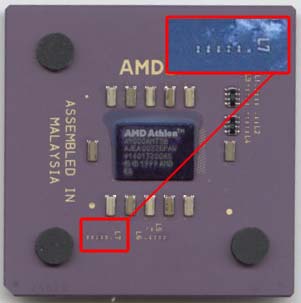
Thunderbird core voltage settings
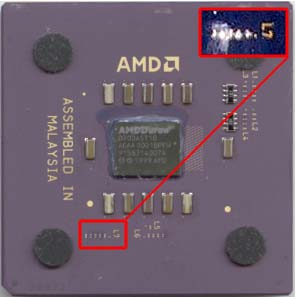
One thing that most KT133 based motherboards will have is the ability to adjust the FSB frequency; however, the KT133 chipset, like it's Slot-A counterpart (KX133), is currently limited to frequencies around 110MHz. Although there are some exceptions where users can push frequencies of 115MHz and higher, generally speaking, FSB tweaking isn't the best way to overclock your Socket-A CPU. If you're faced with no other options then it doesn't hurt, but be aware that there are better methods out there (i.e. multiplier adjustments).
Memory and peripheral expansion doesn't vary too much from one board to the next. However, the one thing that does seem to help boards stand out against each other is whether or not the manufacturer opted to make use of any external storage controllers. Since VIA's 686B South Bridge isn't readily available yet, motherboard manufacturers are turning to AMI, HighPoint and Promise to supply ATA 100 and ATA 100 RAID controllers for use with their KT133 motherboards. If you're interested in keeping your board for a long time, ATA 100 support may come in handy as future drives begin to require it. Currently, there's no real performance benefit that ATA 100 support will result in, but that will change as faster IDE drives hit the streets.
IDE RAID is another interesting feature that can help to get some pretty decent performance out of a pair of IDE drives. If you're not interested in the added performance benefits IDE RAID in mode 0 offers, then running in RAID 1 mode (mirroring) offers added security of a live backup drive. If you have enough drives, a combination RAID 0+1 setting gives you the best of both worlds.
ABIT KT7 RAID
|
ABIT KT7-RAID |
|
|
CPU Interface
|
Socket-A
|
|
Chipset
|
VIA KT133
|
|
Form Factor
|
ATX
|
|
Bus Speeds
|
100
- 183MHz (1MHz increments)
|
|
Voltages Supported
|
1.10 - 2.05V in 0.05V increments
|
|
Memory Slots
|
3 168-pin DIMM Slots
|
|
Expansion Slots
|
1 AGP Slot
6 PCI Slots (4 Full Length) 1 ISA Slot (Shared) |
|
On-board Audio
|
N/A
|
|
BIOS
|
Award Modular BIOS 6.00PG
ABIT SoftMenu III |
ABIT is most definitely back. Although the company went through a phase where we weren't very impressed with their boards, their past few releases have really turned our heads. From the KA7, to the BX133 RAID and now to the KT7-RAID, ABIT is on a roll that has them back on the level they were at when we were all first taken by the name ABIT and their SoftMenu setup.
The KT7-RAID adds a number of features to the standard KT133 based motherboard. In addition to completely getting rid of any AMR slots in favor of a full 6 PCI slots and a single shared ISA slot, the KT7-RAID features an onboard HighPoint 370 controller that supports ATA 100 as well as IDE RAID in modes 0 (striping), 1 (mirroring) and 0+1 (mirroring + striping).
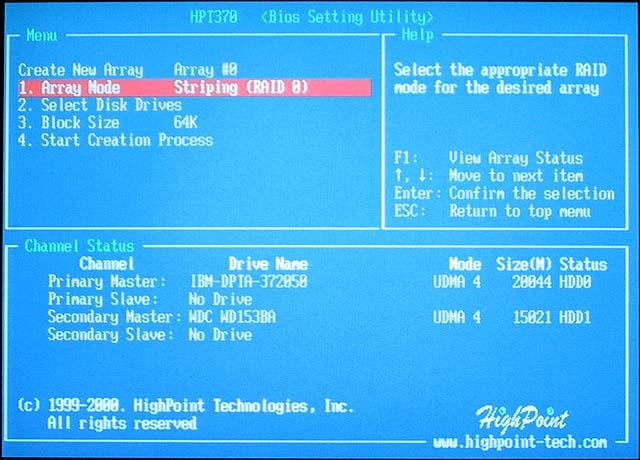
Since the HPT370 controller is present in addition to the VIA 686A south bridge, you have a total of four IDE channels, two of which are powered by the HPT370; the remaining two can be used with ATA 33/66 devices provided by the VIA south bridge.
We didn't have any problems with the HPT370 controller in our tests and setting up the RAID on the controller wasn't too difficult at all (the same as any other RAID controller).
The second interesting feature about the KT7-RAID is that it features a modified SoftMenu III setup that allows for clock multiplier manipulation, voltage tweaking, as well as a handful of other performance and stability enhancing settings.
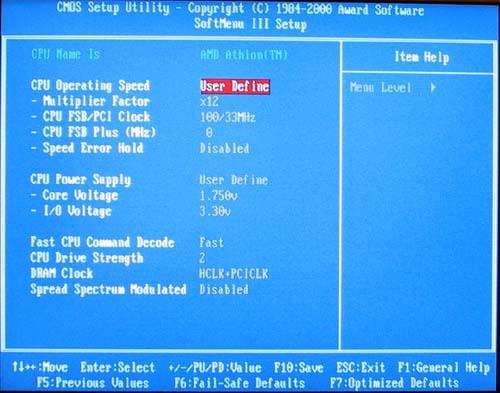
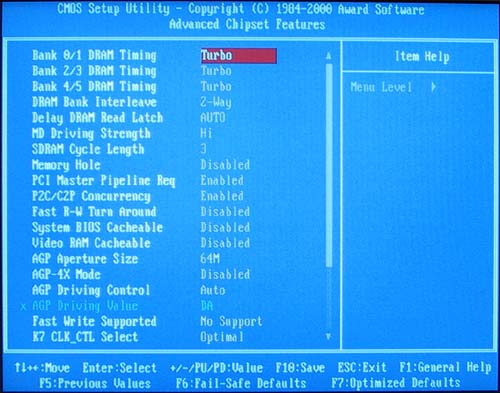
The board features a heatsink/fan on the north bridge which is nice to have but doesn't really help stability to any noticeable degree, it basically drives up the price of the board. Speaking of stability, the KT7-RAID crashed only a single time during our 24 hour stress test, putting it on par with the best of the best in this roundup.
ABIT is also very good about making sure their boards are available at both online vendors as well as your smaller local stores, so it shouldn't be too hard getting your hands on a KT7.
Overall, the KT7-RAID definitely picks up on where the ABIT KA7 left off. It is overall a very impressive solution.
ASUS A7V
|
ASUS A7V |
|
|
CPU Interface
|
Socket-A
|
|
Chipset
|
VIA KT133
|
|
Form Factor
|
ATX
|
|
Bus Speeds
|
100
/ 103 / 105 / 110MHz
|
|
Voltages Supported
|
1.30 - 1.85V in 0.05V increments
|
|
Memory Slots
|
3 168-pin DIMM Slots
|
|
Expansion Slots
|
1 AGP Slot
5 PCI Slots (3 Full Length) 0 ISA Slots 1 AMR Slot |
|
On-board Audio
|
N/A
|
|
BIOS
|
Award Modular BIOS 6.00PG
|
ASUS continues their long string of reliable and high performing motherboards with the A7V.
First and foremost, the A7V impressed us just as much as its predecessor, the K7V, did. The board itself is laid out very similarly to the K7V, the biggest differences being that the board is a Socket-A design and features a unique vertically mounted PCB that contains a lot of the voltage regulators and capacitors that would normally be placed around the CPU socket.
The A7V features multiplier & voltage adjustment controls provided courtesy of a set of on-board dip switches and jumpers. The voltage can be controlled within the BIOS as well as on the board. Remember, that if you do plan on changing the clock multiplier on your CPU, you must make sure that all of the "Golden Bridges" at position L1 are connected; this goes for all motherboards with multiplier control.
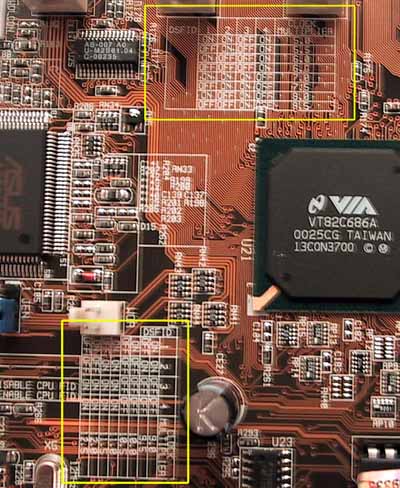
The initial A7V boards did not have multiplier control, so if you're stuck with one of those boards, there is an excellent tutorial on how to outfit the board to allow for multiplier adjustments at Tom's Hardware. But for the most part, if you make sure that you're getting a board with the dipswitches you shouldn't have to modify your board at all.
Like some of the other KT133 boards in this roundup, the A7V also features an additional storage controller for ATA 100 support. The A7V features the same Promise PDC20265 controller that we saw on the Microstar 694D Pro which supports ATA 100 but doesn't support IDE RAID.
Since ASUS has quite a few OEMs that make use of their motherboards it isn't a surprise to see an AMR slot on the A7V, though most AnandTech readers would've rather had a 6th PCI slot take its place.
The A7V features an AGP Pro50 slot just like the K7V, but we have yet to see a card require the use of an AGP Pro50 slot for proper operation. It is a possibility that the standard may catch on in the future but for now the presence of an AGP Pro50 slot isn't really an advantage for ASUS.
Overall, the A7V is just what we have come to expect from ASUS, an extremely flexible, stable, and definitely well-made solution.
Chaintech 7AJA
|
Chaintech 7AJA |
|
|
CPU Interface
|
Socket-A
|
|
Chipset
|
VIA KT133
|
|
Form Factor
|
ATX
|
|
Bus Speeds
|
100
/ 102 / 104 / 106 / 107 / 108 / 109 / 110 / 111 / 112MHz
|
|
Voltages Supported
|
1.30 - 1.85V in 0.05V increments
|
|
Memory Slots
|
3 168-pin DIMM Slots
|
|
Expansion Slots
|
1 AGP Slot
5 PCI Slots (5 Full Length) 1 ISA Slot (Shared) 1 AMR Slot |
|
BIOS
|
Award Modular BIOS 6.00PG
|
Chaintech's 7AJA is an interesting solution, it boasts the company's 3BIOS technology which we talked about in our Computex coverage but other than that is a fairly normally laid out KT133 board. There are three dip switch stations at the bottom end of the board, and it wouldn't be too surprising to see multiplier control listed in the motherboard's manual in the future.
EPoX 8KTA
|
EPoX 8KTA |
|
|
CPU Interface
|
Socket-A
|
|
Chipset
|
VIA KT133
|
|
Form Factor
|
ATX
|
|
Bus Speeds
|
100
/ 102 / 104 / 106 / 107 / 108 / 109 / 110 / 111 / 112MHz
|
|
Voltages Supported
|
1.50 - 1.85v (0.05v increments)
|
|
Memory Slots
|
3 168-pin DIMM Slots
|
|
Expansion Slots
|
1 AGP Slot
6 PCI Slots (1 Full Length) 1 ISA Slot (Shared) |
|
BIOS
|
Award Modular BIOS 6.00PG
|
The 8KTA is pretty much your basic KT133 board, it is laid out very similarly to the ABIT KT7 in that it features 6 PCI slots, a single ISA slot and no room for any AMR slots. While this won't be incredibly attractive to system integrators & OEMs, most AnandTech readers won't mind.
The board does not support any sort of multiplier adjustments although it did support voltage manipulation.
In terms of stability, the 8KTA is pretty much on par with the rest of the boards in the roundup but isn't quite on the level of the ABIT & ASUS entries.
FIC AZ-11
For more information read our full review of this motherboard.
|
FIC AZ-11 |
|
| CPU Interface |
Socket-A
|
| Chipset |
VIA KT133
|
| Form Factor |
ATX
|
| Bus Speeds |
100
/ 102 / 104 / 106 / 107
109 / 110 / 111 / 112 / 133 |
| Voltages Supported |
Auto Detect
|
| Memory Slots |
3 168-pin DIMM Slots
|
| Expansion Slots | |
| Onboard Sound |
Sigmatel
STAC9744T AC 97 CODEC
|
| BIOS |
Award 6.00PG
|
With a bit of work the AZ-11 can be modified to allow for clock multiplier & voltage manipulation, however out of the box you don't get the benefit of those two features.
With the AZ-11 you get FIC's NOVUS II utilities which we go into greater detail about in our review of the board.
The AZ-11 was one of the first readily available Socket-A motherboards, but now with other boards hitting the streets the AZ-11 isn't the top choice any longer.
Gigabyte GA-7ZM
For more information read our full review of this motherboard.
|
Gigabyte GA-7ZM |
|
| CPU Interface |
Socket-A
|
| Chipset |
VIA KT133
|
| Form Factor |
microATX
|
| Bus Speeds |
95
/ 100 / 105 / 110
113 / 115 / 117 / 133 |
| Voltages Supported |
Auto Detect
|
| Memory Slots |
3 168-pin DIMM Slots
|
| Expansion Slots | |
| Onboard Sound |
Analog
Devices AD1881A AC 97
|
| BIOS |
AMI Simple Setup 1.21
|
Gigabyte's GA-7ZM is their microATX KT133 based motherboard, it is unfortunately lacking any jumperless multiplier or voltage configuration utilities.
The board does support FSB adjustments and is quite stable but is very low in the feature department. The same goes for the ATX version of it, the 7ZX.
Gigabyte GA-7ZX
For more information read our full review of this motherboard.
|
Gigabyte GA-7ZX |
|
| CPU Interface |
Socket-A
|
| Chipset |
VIA KT133
|
| Form Factor |
ATX
|
| Bus Speeds |
95
/ 100 / 105 / 110
113 / 115 / 117 / 133 |
| Voltages Supported |
Auto Detect
|
| Memory Slots |
3 168-pin DIMM Slots
|
| Expansion Slots | |
| Onboard Sound |
Sigmatel
STAC9708T AC 97
Creative CT5880 (optional) |
| BIOS |
AMI Simple Setup 1.21
Gigabyte DualBIOS |
Iwill KV200-R
|
Iwill KV200-R |
|
| CPU Interface |
Socket-A
|
| Chipset |
VIA KT133
|
| Form Factor |
ATX
|
| Bus Speeds |
100
- 166MHz (1MHz increments)
|
| Voltages Supported |
Auto Detect
1.70 - 1.85V (in 0.025V increments) |
| Memory Slots |
3 168-pin DIMM Slots
|
| Expansion Slots |
1 AGP Slot
5 PCI Slots (3 Full Length) 1 AMR Slot |
| BIOS |
AWARD 6.00PGN
|
The Iwill KV200-R is the only board in this roundup to make use of AMI's ATA-100/IDE RAID controller which is what sets the KV200-R apart from the competition.
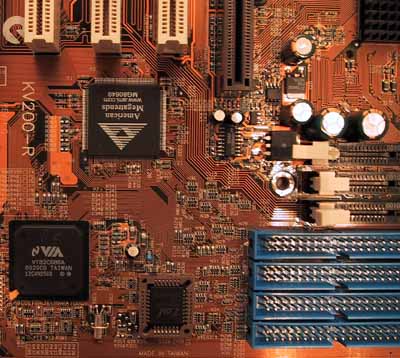
The board also supports Iwill's micro stepping FSB control where you can enter in any frequency between 100 and 166MHz and have the FSB set to that frequency, unfortunately on the Athlon/Duron, most of those settings will be useless because of current chipset/motherboard design limitations.
Unfortunately the KV200-R performed poorly in our performance benchmarks, we are still investigating the cause.
Microstar K7T Pro
For more information read our full review of this motherboard.
|
Microstar K7T Pro |
|
| CPU Interface |
Socket-A
|
| Chipset |
VIA KT133
|
| Form Factor |
ATX
|
| Bus Speeds |
100
/ 101 / 102 / 103 / 105 / 107
109 / 110 / 111 / 113 / 115 / 117 / 120 |
| Voltages Supported |
Auto Detect
1.70 - 1.85V (in 0.025V increments) |
| Memory Slots |
3 168-pin DIMM Slots
|
| Expansion Slots |
1 AGP Slot
6 PCI Slots (4 Full Length, 1 optional) 1 CNR Slot (Shared) 1 ISA Slot (optional) |
| Onboard Sound |
VIA
VT1611A AC 97 CODEC
|
| BIOS |
AWARD 6.00PGN
|
The MSI K7T Pro is a very well made board, boasting excellent stability, a great track record courtesy of MSI as well as a full 6 PCI slots unfortunately the board lacks the multiplier/voltage tweaking settings we've come to know and love which is why it doesn't come away with a recommendation in this roundup. If you're not concerned with overclocking at all, then the K7T Pro is an excellent choice but for most readers, getting the most bang for your buck involves overclocking and the Duron processor, which unfortunately leaves MSI out of the picture.
We have been informed that a later revision of the K7T Pro could possibly feature multiplier control settings, if this does turn out to be true we should see a sample by the end of August.
The K7T Pro board features no onboard ATA-100 controller but some boards may be packaged with an MS-6915 controller card which is basically a Promise Ultra100 Ultra ATA-100 card without a BIOS chip on it, meaning that it can only be used on boards that have the Ultra100 BIOS integrated with the motherboard BIOS, i.e. the K7T Pro.
QDI KinetiZ 7T
|
QDI KinetiZ 7T |
|
| CPU Interface |
Socket-A
|
| Chipset |
VIA KT133
|
| Form Factor |
ATX
|
| Bus Speeds |
100
/ 102 / 104 / 106 / 107 / 108 / 109 / 110 / 111 / 112MHz
|
| Voltages Supported |
Auto Detect
|
| Memory Slots |
3 168-pin DIMM Slots
|
| Expansion Slots |
1 AGP Slot
5 PCI Slots (5 Full Length) 1 AMR Slot 1 ISA Slot |
| BIOS |
AWARD 6.00PGN
|
The QDI KinetiZ 7T was the first motherboard that officially announced that it would be able to manipulate the clock multiplier of the AMD Athlon (Thunderbird) & Duron CPUs. Little did we know at the time that what QDI was boasting wasn't that difficult to accomplish, regardless, the KinetiZ 7T is one of the handful of boards that does support clock multiplier manipulation.
In spite of this there is no voltage control on the board itself, meaning you'll have to adjust the voltage settings manually on the processor itself if you have a conductive pen or some conductive epoxy handy.
The QDI board demonstrated above average stability in our stress tests. The KinetiZ 7T has no external ATA-100/RAID controllers and is a fairly simple design.
The Test
|
Test Configuration |
|
| Processor(s): |
AMD
Athlon (Thunderbird) 1GHz
|
| RAM: |
1
x 128MB Corsair CAS 2 PC133
SDRAM
(using Micron -7E CAS 2 PC133 chips) |
| Hard Drive(s): |
Western Digital 153BA Ultra
ATA 66 7200 RPM
|
| Bus Master Drivers: |
VIA Bus Master Drivers 2.1.47
|
| Video Card(s): |
NVIDIA
GeForce 256 DDR
|
| Video Drivers: |
NVIDIA
Detonator 5.22
|
| Operation System(s): |
Windows
98 SE
|
| Motherboard Revisions: |
ABIT KT7-RAID Revision 0.22
ASUS A7V Revision 1.01 Chaintech 7AJA Revision 1.01 EPoX 8KTA Revision 1.0 FIC AZ-11 Revision 1.1 Gigabyte GA-7ZM Revision 2.2 Gigabyte GA-7ZX Revision 1.0 Iwill KV200-R Revision 1.0 Microstar K7T Pro Revision 1.0 QDI KinetiZ 7T Revision 1.0 |
Gaming Performance

In Quake III the range of scores is much closer than you'd expect, we're definitely dealing with an overall mature group of boards.
Business Performance

The ABIT KT7-RAID pulls ever so slightly ahead of the competition, with ASUS & FIC following closely behind. All of the boards were pretty much in line with one another with the exception of the KV200-R which seemed to have some sort of performance problems. We're still trying to figure out the exact culprit of the board's sub-par performance.

This is an interesting situation, no manufacturer is able to keep up with the performance of VIA's reference board, although the FIC AZ-11 comes the closest.
Final Words
 While
ASUS came in with a very close second, we're going to have to give the best
overall Socket-A KT133 motherboard award to ABIT for their KT7-RAID. The board
is a truly innovative design, bringing ABIT back to the roots that made them
the widely known company they are today. The board boasts a completely
jumperless setup, a plethora of performance & stability enhancing
settings in the BIOS and was overall a very stable solution. The KT7-RAID
also brings its onboard HighPoint 370 ATA-100/IDE RAID controller to the table
as an added feature for those of you that are planning on decreasing the penalty
imposed by one of the biggest bottlenecks in your system, the hard disk subsystem.
While
ASUS came in with a very close second, we're going to have to give the best
overall Socket-A KT133 motherboard award to ABIT for their KT7-RAID. The board
is a truly innovative design, bringing ABIT back to the roots that made them
the widely known company they are today. The board boasts a completely
jumperless setup, a plethora of performance & stability enhancing
settings in the BIOS and was overall a very stable solution. The KT7-RAID
also brings its onboard HighPoint 370 ATA-100/IDE RAID controller to the table
as an added feature for those of you that are planning on decreasing the penalty
imposed by one of the biggest bottlenecks in your system, the hard disk subsystem.
Closely behind ABIT is, of course, ASUS, with their A7V which is just a hair short of tying with ABIT for the first place award in this roundup.
If you aren't concerned with overclocking/multiplier adjustment then there are a number of other motherboards that deserve your consideration, the Gigabyte boards are solid performers as is the Microstar K7T Pro, but if you want a board that truly sets itself apart from the competition then the ABIT KT7-RAID or the ASUS A7V is the right choice for you.
We will be comparing the ATA 100/RAID solutions on all of the motherboards present in this roundup in an upcoming article so stay tuned for that as well.

